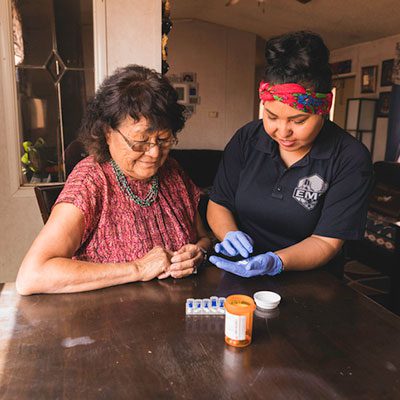Opioid misuse has been an increasing concern in the U.S. over the past two decades and particularly prevalent in American Indian and Alaskan Native (AI/AN) communities. Over the 20-year span from 1999-2019, deaths related to opioid overdose increased rapidly among Indigenous populations, multiplying by more than five times due to increased use of heroin, hydrocodone, oxycodone, fentanyl, and tramadol. The problem is exacerbated when these drugs are used in combination with alcohol and other substances.
In 2020, deaths related to drug overdose were higher for non-Hispanic AI/AN than for any other U.S. racial or ethnic group at 42.5 per 100,000. They rose further to 56.6 deaths per 100,000 Native Americans in 2021 during the aftermath of the COVID-19 pandemic — a sharp increase of 33%.
Perhaps even more concerning for the future, the Substance Abuse and Mental Health Services Administration (SAMHSA) estimated that over 5% of the total AI/AN population in 2019 struggled with opioid misuse. That number included nearly 3% of all AI/AN youth between the ages of 12-17, indicating that Native Americans and opioid addiction will continue to be an issue in the coming years.
A Native American woman speaks with her healthcare provider.
Factors influencing opioid misuse in Native American communities
Social determinants of health (SDOH) are primary contributors to the Native American opioid crisis. Social, structural, and systemic inequities caused by historical and existing trauma have resulted in a lack of funding and access for AI/AN communities and continue to leave them without the critical necessities for their health and well-being. Extreme hardship has created susceptibility to addiction.
Overcoming inequities for Native Americans takes time
While many federal and local initiatives have begun to make progress in addressing some of these problems, centuries of inequities continue to take a toll and cannot be repaired quickly due to their interwoven complexities. Economic disadvantages, unavailable resources, and a lack of social support have created generational impacts that require many different approaches, including a broad range of health initiatives, education, and economic opportunities.
Lack of focus on behavioral health care creates gaps
Many Native Americans rely on health care provided by the federal government. These programs may lack sufficient resources for mental health and addiction treatment. For example, of the 825 Tribal Health, Urban Indian, and Indian Health Service (IHS) healthcare facilities available, only 217 of those facilities offer behavioral health care.
Need for behavioral health programs exceeds availability
In addition to the lack of funding available for programs to address Native American opioid-related health concerns, there are simply not enough mental health providers to serve these communities, despite recent efforts to provide telehealth and increased access to care. Currently, over half of the mental health programs and over 90% of alcohol and substance use programs operate through Tribal Healthcare, whose organizations are not equipped for the volume and type of services needed by their respective communities.
Funding and availability are a dual challenge
To illustrate this double dilemma, consider that over 200 facilities provided behavioral health services to Native Americans, but only 34 of those (from eight IHS areas) received funding through IHS’s Community Opioid Intervention Pilot Projects (COIPP) award program. Further adding to the difficulty, over 70% of those awardees experienced high staff turnover, causing delays in program implementation and decreases in services offered, such as substance use treatment.
What this shows is that funding is not the only answer to effectively address substance use in AI/AN communities. Even with sufficient funding, some areas still lack the human resources to employ these critically-needed Native American health programs.
A story of hope: Bad River Reservation
Native Americans have historically been — and continue to be — challenged with insufficient access to quality health care, fewer economic opportunities, and discrimination. A story from the Bad River Reservation shed light on contributing factors that led to the opioid crisis in AI/AN communities.
Bad River is in an extremely remote area in northern Wisconsin on Lake Superior, where Native Americans have experienced an opioid death rate nearly triple that of the U.S. By late 2023, the Bad River Reservation of 2,000 people had lost a dozen lives.
Oxycontin, a highly-addictive opioid used to treat pain, became scarce as the U.S. began to crack down on opioid use. The lower availability left Native Americans with limited access to health care few options to find relief from chronic pain. As a result, many resorted to heroin, then fentanyl.
To fight this epidemic, the Bad River Band of Chippewa implemented a holistic community-based harm reduction program to help people with addiction. By focusing foremost on reducing harm rather than just restricting use, it made strides in lowering overdose-related deaths. Tactics included providing sterile syringes and pipes, distributing the overdose-reversal medication naloxone, and encouraging the use of test strips to detect potentially lethal fentanyl or xylazine (“tranq”).
Through these efforts, Bad River reported saving over 100 lives in 2023 by reversing overdoses. They saved 30 lives in September alone — preventing a death from overdose for every day of the month.
Surprisingly, the people leading the Bad River initiatives were not healthcare workers, nurses, behavioral health professionals, or addiction counselors. The project was led by community member Lisa Whitebird, who saw a need and stepped in to fill it.
A holistic approach could help Native Americans and opioid addiction
Taking a holistic approach to substance use and standardizing integrated behavioral healthcare models into all healthcare services could be effective for reducing opioid misuse, overdose, and harm related to opioid use. According to research, it could also be more cost-effective than other treatment strategies. Education and awareness are cornerstones of this approach.
Providing wider education and awareness
IHS’s COIPP held multiple community education events covering topics such as prevention of opioid use disorder, accessing opioid-specific services, recognizing overdose, and administering naloxone. They found that most attendees did not know what naloxone was, how to acquire it, or how to use it in the event of an emergency.
Providing community education through live events can effectively reach people who need training, and patient and family educational resources can help more people address opioid use and perform crisis intervention. However, education alone won’t solve the problem. Barriers still exist due to social factors.
To put it in perspective, the COIPP awarded a total of $10 million toward community awareness and education for establishing partnerships, building support systems, and expanding access to mental health services. Over 20,000 Native Americans from the community and from healthcare backgrounds attended events to learn about opioid use — about 4.5% of the nation’s Native American population. But more than double that number died from opioid overdose in 2021.
Building a pipeline of healthcare professionals
In addition to increasing awareness, we must increase the supply of qualified mental health professionals. Throughout my career as a nurse serving in AI/AN health care, I witnessed the inability of those needing mental health services to access that care due to the lack of licensed mental health professionals available.
Following the successful model of Bad River, we should provide education to community members and family members who have the potential to serve — as well as all clinical and nonclinical healthcare service providers — to equip those who can make a difference with the tools and resources they need to develop the knowledge, skills, and ability to intervene during opioid crises and provide primary prevention. We need to support our loved ones by equipping those who can help to support those dealing with substance use disorders.
Developing the best healthcare professionals
For those already in the healthcare field, ongoing professional education is critical for providers and clinicians to acquire the latest evidence-based practices and keep up with changing practice standards. Substance use counselors and behavioral health practitioners support other clinicians and staff during crisis intervention, treatment, and patient education. And all staff, clinical or not, must be prepared with professional education for crisis encounters with individuals in distress.
For example, has every clinician who might encounter an overdose taken training on administering naloxone? Can they identify an individual who is overdosing? Do they know the signs and symptoms of addiction? Can they make the appropriate referral or coordinate care with the right resources — or know the appropriate next steps when resources might not be available?
Education is the key to saving lives, and our communities depend on us to be the best we can be, even amidst staffing challenges and limited resources — and even more so because of those challenges.
This is the second article in our series examining challenges in Native American health care.

Evidence-Based Government Healthcare Training Solutions
Relias can help your government organization improve patient care and outcomes with our proven, data-driven solutions. We support your clinicians on their journey to competency — and your organization’s journey to excellence.
Explore solutions →






